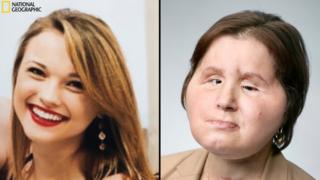 Image copyright
Image copyright
Family/Martin Schoeller
The procedure was carried out in May 2017 by 11 surgeons at the Cleveland Clinic in Ohio
Katie Stubblefield was only 18 when she was severely injured by a self-inflicted gunshot wound.
Her life was saved in hospital, but the young woman had life-changing injuries and had lost most of her face.
Now 22, the youngest US recipient of a face transplant has shared the results of several years of exhaustive reconstructive surgery with National Geographic magazine.
The publication was given unprecedented access by an Ohio clinic which operated on Katie when she was just 21.
A journalist and photographers followed her preparation and the results from the invasive 31-hour procedure.
The Story of a Face is on the cover of the magazine’s September issue, and Katie’s story is also told in a documentary online.
There have only been 40 recipients of a face transplant throughout the world. The first full-face procedure was successfully carried out by Spanish doctors in 2010.
But because surgery is still considered experimental, it is not covered by US insurance providers.
Katie’s surgery was eventually funded by the Armed Forces Institute of Regenerative Medicine, which wants to improve treatment of military personnel who are injured at war.
Katie, now 22, was deemed a good candidate because of her age and the nature of the injuries she had sustained.
The transplanted face came from 31-year-old Adrea Schneider, who died from a drug overdose in 2017.
- First double face transplant ‘well’
- Transplant patient ‘overwhelmed’ by result
- What’s it like living with a face transplant?
She was already an organ donor, but the decision to donate her face came from her grandmother, Sandra Bennington, who has since met Katie following the surgery.
Image copyright
Benningdon Family/Maggie Steber/ National Geograph
Adrea’s grandmother said she recognised some features of her granddaughter (L) in Katie now
Katie says she cannot remember much about the period before her suicide attempt, but family say she had been struggling emotionally with moving around, a failed relationship and chronic gastrointestinal health problems throughout her teens.
The bullet wound destroyed much of her face – including her nose, some of her forehead and jawbone. She also had brain injuries and significant damage to her eyes.
After being initially treated in Mississippi, she was transferred to Tennessee before ending up at the Cleveland Clinic in Ohio – a facility already performing pioneering transplant procedures.
Before the transplant, Katie had already undergone 22 reconstructive surgeries, including using her thigh and 3D printing to help reconstruct her jaw.
She and her family say they did not even know what the procedure entailed when they were notified she could be eligible.
“I had no clue what a face transplant was,” Katie said. “When my parents helped explain everything to me, I was very excited to get a face again and to have function again.”
After a year on the transplant list and having two donors fall through, she eventually underwent the procedure in May 2017.
Image copyright
Maggie Steber/National Geographic
Her mother Alesia (R) said her daughter wanted the surgery to not be stared at in public
Initially it was supposed to be a more partial procedure, but the decision was taken to use more of the donor’s face to improve the match.
Since the operation, she has had three revision surgeries. More operations are likely in order to improve appearance and functionality of the face.
Katie still has difficulty speaking because of the damage done to her mouth. She will have to take medication for the rest of her life to reduce the risk of transplant rejection.
‘Second chance’
The young woman told National Geographic she hopes to go to college and eventually go into counselling.
She has also expressed an interest in speaking to teenagers about suicide and the value of life.
“So many people have helped me; now I want to help other people,” she said.
Dr Brian Gastman, a plastic surgeon at the Cleveland Clinic, said Katie had received the “ultimate second chance” through the procedure, CNN reports.
“My first wish for Katie is to be happy,” Mr Gastman said. “That’s number one, but beyond that, I’d like her to have some level of normalcy.
“Then, she can do all that and become a spokeswoman for so many aspects – for how to be strong in the face of adversity and not to make a singular decision dictate who you are.”
If you are need help over issues raised in this story
From Canada or US: If you’re in an emergency, please call 911
You can contact the US National Suicide Prevention Lifeline on 1-800-273-8255 or the Crisis Test Line by texting HOME to 741741
Young people in need of help can call Kids Help Phone on 1-800-668-6868
If you are in the UK, you can call the Samaritans on 116123
For support and more information on emotional distress, click here.
Face transplant: A ‘second chance’ for young suicide survivor

